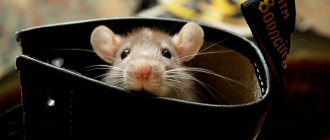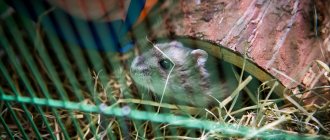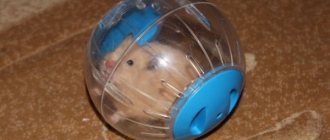It happens that small rodents get lost and hide somewhere. What to do? How to catch a hamster in an apartment? Don't panic under any circumstances, stay calm. The article will give useful recommendations that will help you. The main thing in this matter is to be patient.
So, how to catch an escaped hamster? Don't worry! If your rodent is in the apartment, then it is very likely that you will find it. It is possible that you will not need a day or two for this. Try not to make sudden movements so as not to scare the hamster.
Be sure to close the doors to prevent the rodent from escaping. Seal all cracks, if any. You should not open the windows so that the hamster does not accidentally fall out.
As soon as you realize that the rodent is not in the cage, immediately remove other animals (dogs, cats, etc.) from the room. This is necessary so as not to create unnecessary stress for the hamster.
How to catch an escaped dwarf in an apartment
If your beloved pet is missing, try to secure the area:
- Remove dangerous objects from the floor. Get rid of any items that could injure or poison the escaped rodent.
- Warn your household. The whole family should be aware of the loss so as not to accidentally step on the animal. Loud noises can frighten your hamster, so make no noise and remain calm.
- Isolate other pets that might eat the little escapee.
- Eliminate possible travel paths. Close interior doors and do not leave the toilet open.
Once you are sure of safety, begin your search immediately.
Hamsters are true escape artists and can escape at any time.
Where to look and how to lure
A hamster, when it has escaped and is free, does not remain in a state of euphoria for long, which is quickly replaced by fear. In an unfamiliar environment, the rodent tries to find a quiet, warm, dark and secluded place, so pay attention to the places:
- behind the toilet;
- under the refrigerator;
- next to the cage;
- behind and under furniture;
- behind the washing machine;
- on shelves and in drawers;
- under interior items;
- in bags;
- behind batteries and pipes.
Listen for extraneous sounds and check for any cracks and openings that could attract a fugitive.
Traps
Having decided on the location, use 1 of 2 trap options:
- Bucket. To organize this trap: choose a bucket with a height of no more than 25cm; use oil to lubricate the inner walls; cover the bottom with a soft towel or sawdust; organize ladders from books, planks or children's construction sets, allowing you to climb to the top of the bucket; spread a napkin or sheet of paper covering the hole in the bucket; place treats on the steps to lure the animal; Place most of the treats on top, preventing the leaf from falling under their weight. Don't overdo the number of treats on the steps. If the hamster eats before the final goal, the plan will fail.
- Humane mousetrap. This trap differs from the classic one in that the caught animal remains safe and sound. Use the rodent's favorite treat as bait. Use this trap as a last resort. Sometimes the device malfunctions.
Hamster trap
Lures
Use your pet's favorite treats as bait:
- sunflower seeds;
- favorite food;
- slices of fruit or vegetables.
If you leave it on the floor in the public domain, then the hamster, having noticed its home, will quickly rush to its home place. Sometimes hamsters return to their home on their own.
Tracking a fugitive
If the pet's location is still unknown, then start surveillance:
- Place the treat on: rustling foil, allowing you to track the fugitive by sounds; floor sprinkled with flour or starch (a path from small paws will indicate the place of shelter).
- Be vigilant at night. Rodents are nocturnal animals, so finding them during the day is much more difficult. Remove all extraneous sounds and try to recognize the rustling sounds of the hamster.
A thrown blanket will discourage, but will not harm the animal, allowing it to be captured before the escape is recaptured.
Traps
It happens that all of the above actions did not lead to the capture of the fugitive. Then you will need a hamster trap that is easy to make with your own hands. The trap will help both lure the hamster out from under the closet and keep him in. Don’t be alarmed, this device is very humane and will not harm your pet.
Trap tube
If the animal is hiding under a closet or bed, you can catch it with a snorkel. The snorkel is most often used to catch a rodent that is not used to being handled. Don't know how to make a hamster trap? Everything is very simple:
- Take a paper towel roll.
- At one end attach a fragrant treat.
- Seal the tube on the bait side.
- Point the open end towards where the hamster is hiding.
When the homa comes to eat, cover the entrance with your palm and transfer the trap tube into the cage. Lift the sleeve carefully so as not to scare the fluffy one!
Bottle trap
You can catch a small animal using a plastic bottle trap. It is most convenient to make a device from a 2-liter bottle with flat walls (so that the trap does not swing in different directions).
Cut off the bottom on three sides, leaving the fourth intact. Bend it up and secure it in this position with an elastic band. In this trap, the door will not slam shut; air must flow through the entrance. Attach a bridge to the bottom edge of the bottle so that it goes up inside the bottle and bends slightly under the weight of the tiny creature. The center of the bridge should be rubbed with a nut, and the treat itself should be placed inside the bottle.
The hamster, sensing the aroma, will go into the bottle, chew the treat, but will not be able to jump back onto the bridge. This is where you catch the animal!
Bucket trap
Usually, they try to catch rodent pests using a bucket by pouring water into the bottom. We don’t want to cause harm to the funny little animal, so we line the bottom with a thick layer of sawdust or hay so that the hamster doesn’t hurt himself when he falls.
So here are the instructions:
- take a bucket, pour a shockproof layer of bedding inside;
- cover the trap with a sheet of paper;
- place a treat on top.
- attach a “ladder” to the bucket (ruler, ladder made from books, etc.);
- Place a seed on every 2-3 steps.
The fluffy miracle, making its way up the stairs, realizes that there is something tasty at the top. Seeing the bait, the pet will stand on the paper and fall into a bucket on a soft bedding, where it will wait for the owner. The little animal will not be able to get out of the bucket because of the high edges.
Prevention of escapes
To minimize the risk of another escape, follow these recommendations:
- Make sure there is a sufficient frequency of rods. The smaller the hamster, the easier it is for him to get through the bars.
- Try to eliminate the animal's boredom. Lack of communication and a small number of toys are a common reason for escape. Don’t forget to walk your pet around the apartment after securing the area.
- Buy only reliable structures made of metal. Rodents love to chew on cages, so sooner or later they may chew their way to freedom.
- Analyze the cell daily for damage. When fixing unknown holes, be sure to patch them.
- Make sure the door is securely fastened. Large Syrians easily swing open the loosely secured door. For added security, hang a metal lock on the outside of the cage.
- Think about stressors. Remember that hamsters should not be kept near a constant source of noise. Place the cage only in a quiet and peaceful place.
How to quickly catch an escaped hamster
Hamsters are one of the most popular pets in people's homes. However, owners need to be constantly on alert: the rodent uses every opportunity to escape to freedom. This can happen anywhere - during a walk, a trip, or even if the doors and roof of the house do not close well. What to do if you still lose sight of the animal? Catch it urgently - after all, your missing pet could climb into a dangerous place or become crushed! How to catch an escaped hamster in an apartment?
Search strategy
How to find a hamster in an apartment, using knowledge about some of the habits and habits of these animals? For example, it is known that hamsters are nocturnal animals, that is, at this time their activity increases. If you haven't found it before evening, don't get upset. Most likely, closer to midnight, people will start running around the apartment and then you can quickly notice the loss. But be careful with the rest of the family - don’t accidentally step on the animal.
Use a bait trap. Place a few sunflower seeds in some corners of your home - and the rodent will not keep you waiting. If you don't take him by surprise, you'll at least have a rough idea of where the pet is hiding. Of course, if the loss of seeds is not the work of hungry household members. Or you can be even more cunning - sprinkle the floor around the piles of seeds with flour or starch. Then the white footprints will lead you to the shelter of the lost homa. Another method to find it is to lay foil or other “rustling” material on the floor in the area of the intended hiding places. At night, hide nearby and listen to the surrounding sounds, trying not to make unnecessary movements.
Simple tips on how to find an escaped hamster in an apartment will help you determine its location. But the process of capture itself is also not an easy task. How can you competently deal with it?
Signs of pests
How to understand that these voracious pests have appeared on your summer cottage? Here are signs that hamsters are visiting the garden:
- presence of large minks;
- several chains of footprints indicating the route of movement;
- scattered food along the route;
- the appearance of new holes with more supplies;
- the carrion of apple trees and other fruit trees is folded into neat piles;
- bitten ground vegetables, gnawed tubers, disappearing berries.
Sometimes the symptoms of hamsters are confused with moles and voles. But these rodents are much smaller, and accordingly their minks have a smaller diameter (up to 5 cm).
How to find a hamster
The creatures are tiny and timid (especially the Djungarian), having escaped from the cage, they will very quickly hide in a secluded corner. Surely, you yourself know where these are located in your own apartment. The sooner you start your search, the greater your chances of finding the fugitive. Attention! If there are predatory animals in the house, immediately isolate them while searching.
Use different traps
Here is an approximate algorithm for how to catch a hamster and locate its location:
- explore the space closest to the cage;
- Look behind and under furniture, including pillows;
- take care of bookcases, shelves, chests of drawers, sideboards: pay attention not only to the furniture, but also to the contents;
- check upholstered furniture for holes and openings where a pet could climb;
- look into boxes, bags, wallets, shoes and other deep things;
- carefully inspect instruments and equipment;
- pay attention to the holes in the walls: the hamster could crawl under the wallpaper or baseboard, or even climb over to the neighbors.
It’s good when you can roughly guess where and in what part of the apartment the rodent has hidden. Then you can narrow your search. But what to do if your hamster ran away in an unknown direction? It's time to use cunning to identify the fugitive.
How to catch an escaped hamster
How to catch a hamster if it has escaped from its owners? These animals are quite nimble and energetic, even if they are comfortable in a cage, they will happily take the opportunity to run around the apartment, in nature. They run away during games or walks. When escaping, it is necessary to find and return the animal to the cage as quickly as possible, because many dangers await it outside. Therefore, the owner should urgently locate the escaped pet, lure it out of its hiding place and place it in a safe home.
Traditional methods
To get rid of hamsters in the countryside, what folk remedies do experienced gardeners use? We bring to your attention proven and effective folk methods that have been used by summer residents for decades.
Pest ash
Wood ash
The prepared substance must be poured into the burrows of the animals and sprinkled on the places where they move on the surface. As you know, wood ash contains alkali, a corrosive substance. As the animals move, the ash will irritate the surface of the paws. Rodents will lick off the black coating. This way the alkali will get into the mouth and stomach of the rodent. As a result, severe inflammation will begin, and the rodent will simply be forced to leave the area it has chosen.
Flour with alabaster
Mix both substances in equal proportions. Pour the mixture near each hole, and place a drinking bowl with water nearby. This substance has no odor, so the hamster will try it without any suspicion, and after that he will want to drink. After reacting with water, alabaster begins to harden inside the animal’s stomach. As a result of this, death occurs. Remember - you only need to use wheat flour to prepare this mixture.
Wine cork pieces
Crush the wine cork as finely as possible. Add the crushed pieces of bread to the crushed mixture. Then pour in a small amount of vegetable oil and stir. Place the prepared mixture near the entrance to the holes. When a substance enters the stomach, the plug begins to swell and get stuck in the intestines. All this ends in death for the pest.
Quicklime
Mix sugar with quicklime and pour the substance into the holes. The corrosive mixture, entering the stomach of a rodent, causes severe burns and death. Literally a quarter of an hour later the animal dies.
Search Locations
Detecting a fugitive is complicated by the fact that he is small in size and can hide almost anywhere. If you see where the hamster ran, immediately examine the area. If you don’t find him, close the door to the room to prevent him from leaving the room. So, what to do if your hamster escapes from its cage:
- Examine the secluded corners near his home. As a rule, animals do not go far from their home.
- Check the holes in the floor, walls, appliances - kids often climb into ready-made “holes”.
- Look under beds, sofas, closets, on shelves, in boxes, behind furniture, under pillows. Move large items aside and open drawers.
- Browse bags, backpacks, cosmetic bags, wallets.
- Remove carpets and rugs from the floor - the animal can easily get under them.
- The hamster may well hide near the radiator or under the sink, because he loves warmth.
- If there is a pantry in the house, the fluffy will happily sit in it: it is warm and there is food. In this case, it will not be easy to lure him out.
These animals cannot jump high, so you should look for them in the lower part of the premises. Rodents prefer narrow, dark, enclosed places.
Traditional methods of rodent control
To clean gardens from pests, traditional methods of fighting hamsters are also used:
- Use of wood ash. It is crushed and poured into burrows. The alkali contained in it corrodes the paws of rodents.
- Place a mixture of wheat flour and alabaster near the burrows, next to which a container of water is placed. After eating the dry mixture, the animals drink water. When it enters the stomach, the alabaster hardens and the pest dies.
- The wine cork is crushed and mixed with bread, adding sunflower oil to the mixture to bind the components. After entering the rodent's stomach, the pieces of cork swell and clog the intestines, which leads to the death of the animal.
- Sugar is mixed with quicklime and placed in holes. After eating, the stomach gets burns and after ten to fifteen minutes the hamster dies.
Also, to prevent the appearance of pests, you can plant the area with plants whose aroma rodents cannot tolerate.
Ways to track a fugitive
Hamsters are nocturnal creatures, so you are more likely to find them in the dark. First of all, to catch a runaway hamster in your apartment, listen and inspect the home. In silence, you can easily hear rustling noises, and if you look closely, you will find the excrement of an escaped pet. Place some food in each room and close the doors tightly. In the morning, look at the treats left, if they are scattered or there are fewer of them, the pet was there.
To accurately identify your baby's hiding place, sprinkle flour or starch around the treats, as well as near the doors and near the suspected location of the rodent. The tracks left by the hamster will help track its movements.
An alternative option is to place bags, foil or something rustling on the floor and surfaces on which the hamster can move. With the help of such an “alarm” you will track down the baby who has escaped from the cage.
Description of the animal
The field hamster, which is also called the garden, common and carbysh, is a very voracious pest of agricultural land. The length of their well-fed body is more than 30 cm (excluding the tail), and the weight of an adult animal is more than 600 g! Can you imagine how many resources are needed to feed such an animal? In addition, during the warm season, these animals actively reproduce: in the southern regions of Russia, one female is capable of leaving 3 litters a year, and this is up to 40 babies, which after 2 months are able to copulate.
Wild hamsters live in the southern and central parts of Russia, preferring the steppe zone and forest-steppe. Pests settle in meadows, fields, forest edges, and along water bodies. It is important for hamsters to have a source of food nearby, but when it runs out, these pests can run 2-3 km for supplies. They do not eat all the food they get at once, but save it for a “rainy day.” Their cheeks are so large that they can hold up to 50 g of dried grain! Field hamsters store their “stash” in long, winding labyrinths with many entrances that they build underground. The earthen passage is intricate; the branches contain living rooms and barns for supplies. The length of the hole with all the forks can reach 10 m. Can you imagine how much you can hide there?
In summer and early autumn, after harvesting grain from the fields, field hamsters rush to summer cottages.
How to catch a hamster
There are several ways to catch a fluffy one. Let's consider all the options, starting with the simplest.
- Place an open cage in the middle of the room. Probably, the hamster has already missed his home and delicious food, then at night he will return home. Make a ladder so he can climb inside, put his favorite treats in the feeder, and pour clean water into the drinking bowl.
- If you see an animal that has come out to enjoy the leftover treat, carefully approach it and cover it with a light cloth napkin. This will prevent him from escaping again.
- Does your pet like to run in a wheel? Leave your favorite exercise machine in the middle of the room and leave it. Hearing the familiar sounds of a spinning wheel, go after the fugitive.
- If you were not successful with the previous methods, a hamster trap will help you. Several design options have been invented that help to safely catch the animal.
Glass jar
There is an option for another trap. But it can only be used if you constantly monitor it. You will need 5 kopecks and a glass liter jar. Place the latter on a slant on the coin so that there is room for the rodent to climb into the jar. To bait, place a tasty treat for your pet in the middle of the jar. As soon as he approaches the “yummy”, the jar will cover him and he will need to be taken out immediately so that he does not suffocate. So be sure to keep an eye on the can if you use a trap like this.
Features of catching a hamster in nature
Catching a hamster at home is not too difficult a task. What to do if the animal runs away into the street?
You can use the traps described above: they do not injure the animals. However, when placing such devices in nature, you risk catching not your pet, but some wild rodent, so be careful that the living creature does not bite you.
If there are burrows of other animals near your home, the hamster probably climbed into one of them. Try to flood them. Fleeing from the water, the hamster will get out into the street, where you will catch it.
Difficulties in searching
Searching for a hamster in a private house or apartment is complicated by the fact that owners can inadvertently injure it with a door or furniture. The baby can climb into a small gap from which he will not be able to get out. Another difficulty is that without finding food and water, the animal may die of hunger. Therefore, leave treats in the rooms to lure the hamster and prevent him from starving to death.
If there are cats, dogs or other pets in the house, they may eat the small pet. The same danger exists on the street, where there are even more predators. Domesticated hamsters are not adapted to survive in the wild. Try to make sure that the fluffy cannot escape.
Destruction method
The modern market of pesticides offers several means of exterminating rodents on the site. How to fight hamsters in the garden using poisonous agents? Read below.
Lures
There are two effective methods that will help you get rid of rodent pests.
The first remedy is arc traps. The principle of their operation is similar to conventional mousetraps. The prepared device is placed right at the entrance of the hole. It must be said right away that this method of fighting rodents is ineffective. Firstly, you can only catch one rodent with this device. Secondly, a rodent caught in a trap immediately transmits information about the danger to all its relatives in the area.
You can use poison baits with poison. The poisonous substance is poured into feeders installed near the holes, or poured directly into the hole. In order for an animal to try this food, it must first be fed something tasty. The effectiveness of such a means of combating wild rodents depends on the quality of the toxic substance.
Pesticide
To completely exterminate pests in your dacha, you will need a special substance - rodenticides. This is an effective poison that can be purchased at a specialty store.
In the modern industry for the production of pesticides, there are several drugs of this group. One technique is enough to kill harmful animals in the garden:
- Varat. An effective drug that destroys any rodents, including hamsters. It is already sold as bait in granular form. This product can be used in the autumn after harvesting, as well as in the spring, when animals are actively searching for food.
- Klerat is a ready-made granular poison. An important rule is that it can only be used on dry soil. Due to the risk of human intoxication, baiting of rodents with this means is carried out by special services.
- MB final. A poisonous substance with a paste consistency, used to add to food for pests. A single application is enough to destroy all rodents on the site.
- Rat death. An effective drug intended for systemic use throughout the year.
The use of the above drugs is carried out according to the instructions that come with it or are indicated on the packaging.
After getting rid of harmful rodents in your garden plot, try to inspect it regularly. To prevent repeated pest invasions, get a cat or dog that will periodically inspect the area.
Escape prevention
To prevent your hamster from running away from you, make sure that he is comfortable in the cage. The following recommendations will help you:
- Create a calm environment for your baby; do not place the cage next to TVs, speakers, or loud appliances.
- If the animal wants to sleep, do not disturb it, otherwise it will try to hide in a secluded place.
- Do not leave your hamster unattended outside of its cage.
- The home must be suitable in size for the fluffy.
- The distance between the rods should be such that your pet does not fit between them.
- Make sure the cage is secure; the hamster can easily gnaw through thin metal or wooden rods, sharpening his teeth several times.
- When cleaning the house, transfer the pet to a box or a walking ball.
Compliance with these measures will help you not to lose your hamster and not worry about it.
Distribution and reproduction
The wild hamster is a very unpretentious animal ; it is not afraid of arid steppes, mountains, forests, or proximity to humans. Distributed almost everywhere, from Europe to China.
The pest is not afraid of the harsh climate. He takes refuge safely in his hole. The main thing for rodents is to have something to eat, so they usually settle near fields and gardens.
Help : the wild hamster is an omnivore, but its diet contains more plant foods, such as corn, wheat, potatoes, peas, buckwheat and many others. It also feeds on seeds and rhizomes of wild grasses and shrubs. However, he does not disdain animal food; he eats insects, mollusks, small crustaceans, etc. There were even cases of hunting mammals, such as mice and rabbits.
They get close to dachas and villages to make supplies from the harvest in their gardens. Farmers are suffering from these pests everywhere, inventing new ways to combat them.
Important ! Rodents reproduce very actively, reaching sexual maturity at the age of 20 weeks.
One male usually creates families with several females. The cubs are born blind and bald, but they grow very quickly and soon become involved in the process of replenishing the population.
A female wild hamster gives birth in the spring, and can sometimes give birth several times a year, under favorable conditions. They reproduce exponentially, with litters usually ranging from 6 to 18 cubs .











